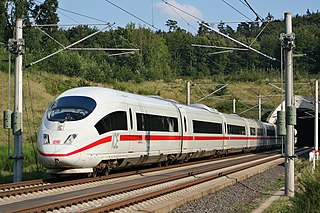
A multiple-unit train or simply multiple unit (MU) is a self-propelled train composed of one or more carriages joined, which when coupled to another multiple unit can be controlled by a single driver, with multiple-unit train control.

The 100 series was a Japanese Shinkansen high-speed train type which operated between 1985 and 2012 on the Tokaido Shinkansen and Sanyo Shinkansen high-speed lines. They were introduced after the 200 series trains, but their numbering is such because in the days of Japanese National Railways (JNR), Shinkansen types running east of Tokyo were given even numbers and those west of Tokyo odd numbers, hence they were given the next odd number in line after 0, 100. The last remaining examples of the type were withdrawn from service following the last runs on 16 March 2012.

Ferrovie dello Stato Italiane S.p.A. is Italy's national state-owned railway holding company that manages transport, infrastructure, real estate services and other services in Italy and other European countries.
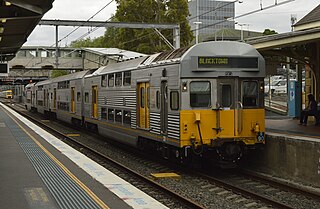
The S sets were a class of electric multiple units that operated on Sydney's suburban rail network from 1972 up until 2019. Originally entering service under the Public Transport Commission, the sets also operated under the State Rail Authority, CityRail and Sydney Trains. Prior to their retirement, the S sets were the last class in the Sydney Trains fleet to not be air-conditioned, earning them the nicknames "Tin cans" and "Sweat Sets". They were also nicknamed "Ridgys" because of their fluted ("ridged") stainless steel panelling; they shared this nickname with similar looking K sets and C sets. The final sets were withdrawn from service in June 2019.

British Rail Class 416 (2-EPB) was a class of third-rail electric multiple units in service between 1953 and 1995. They were intended for inner suburban passenger services on London's Southern Electric network. There were two subclasses of Class 416: Class 416/1 to an SR design on salvaged 2-NOL underframes, built between 1953 and 1956, and Class 416/2 based on a British Railways Mark 1 coach design.

The British Rail Class 306 was a fleet of electric multiple unit (EMU) trains introduced in 1949. It consisted of 92 three-car trains which were used on the Great Eastern Main Line between Shenfield and London Liverpool Street.
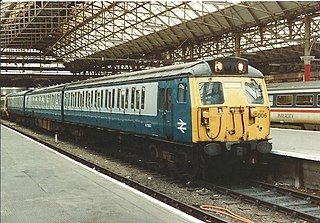
The British Rail Class 304 were AC electric multiple units designed and produced at British Rail's (BR) Wolverton Works.

British Railways Class 505 were 1,500 V DC electric multiple units (EMUs) introduced in 1931 by the Manchester, South Junction and Altrincham Railway (MSJAR). Although assigned to TOPS Class 505 by British Railways, these units were withdrawn before the TOPS numbering system came into common use for multiple units, and the Class 505 designation is very rarely used.
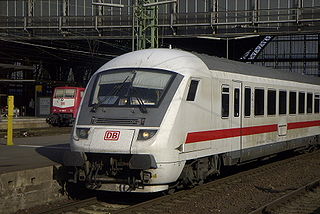
A control car, cab car, control trailer, or driving trailer is a non-powered rail vehicle from which a train can be operated. As dedicated vehicles or regular passenger cars, they have one or two driver compartments with all the controls and gauges required to remotely operate the locomotive, including exterior locomotive equipment such as horns, bells, ploughs, and lights. They also have communications and safety systems such as GSM-R or European Train Control System (ETCS). Control cars enable push-pull operation when located on the end of a train opposite its locomotive by allowing the train to reverse direction at a terminus without moving the locomotive or turning the train around.

E.402A/B is a class of electric locomotives mainly used on medium speed passenger trains by the Italian railway company FS Trenitalia.

Line 2 is an 18.9-kilometre (11.7 mi) commuter rail line, part of the Naples Metro in Naples, Italy. As of January 2024, Line 2 connects 12 stations. It is operated by Trenitalia.

FS ALe 642 is a class of Italian Electric Multiple Unit trains built from 1991 to 1995 for use on secondary lines and for commuter traffic. In service since 1991.
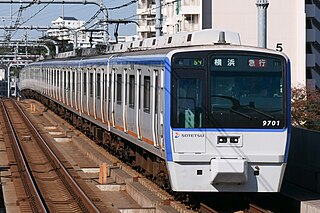
The Sotetsu 9000 series (相鉄9000系) is a DC electric multiple unit (EMU) type operated by the private railway operator Sagami Railway (Sotetsu) on commuter services in Kanagawa Prefecture, Japan, since 1993.

The SNCF Class Z 50000, also known as the 'Francilian', or 'NAT' is a type of dual-voltage electric multiple unit trainset designed in the 2000s. It is commuter rail system serving Paris and its Île-de-France suburbs on the Transilien network. Departing stations are Gare du Nord, Gare de l'Est and Gare Saint-Lazare.

The Taiwan Railway EMU100 series was a set of rail cars fabricated by British Rail Engineering Limited and the General Electric Company in 1976 that has operated in Taiwan. The alternating current electric multiple unit (EMU) fleet entered full squadron service in 1979, and was withdrawn from service in 2009. This class of railcars were the first to operate on the electric Tzu-Chiang Express. Due to the unit's British origin, rail buffs have variously nicknamed them "British Girl", "British Lady", or "British Grandma".
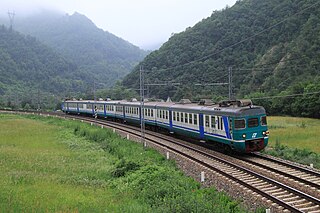
The ALe 801/940 are a series of EMUs built in the 1970s for the Italian state railway FS, now used by its successor, Trenitalia.
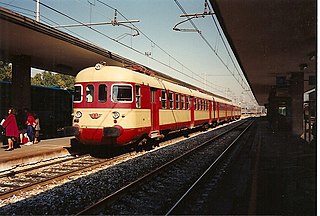
The ALe 803 are a series of EMUs built in the 1960s for the Italian state railways FS, and now used by the railway company Trenitalia.

The ALe 724 are a class of EMUs of the Italian Ferrovie dello Stato, projected for suburban and regional services.

The Keihan 7200 series is an electric multiple unit (EMU) commuter train type operated by the private railway operator Keihan Electric Railway in Kyoto, Japan, since 1995.

The Keihan 6000 series is an electric multiple unit (EMU) commuter train type operated by the private railway operator Keihan Electric Railway in Kyoto, Japan, since 1983.

























